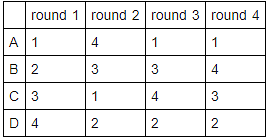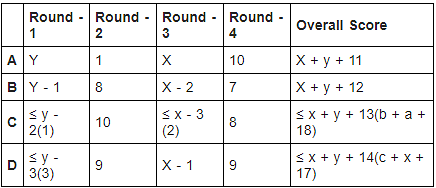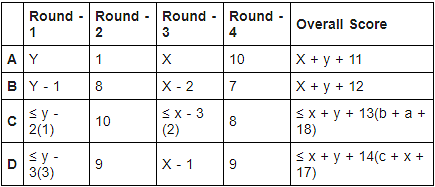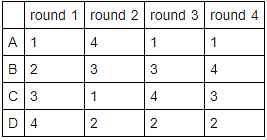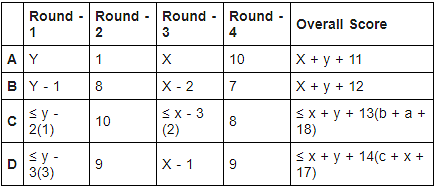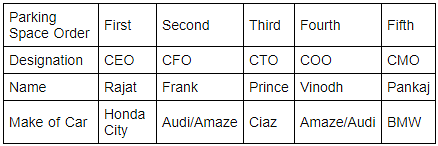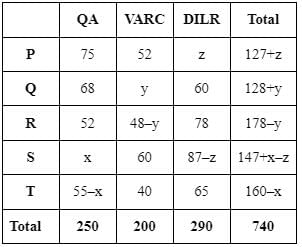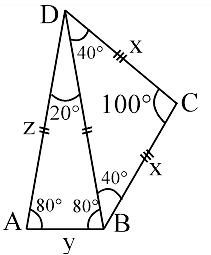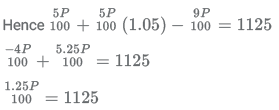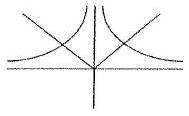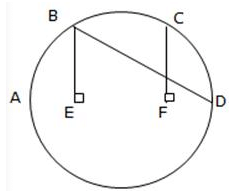CAT Mock Test - 18 (November 20) - CAT MCQ
30 Questions MCQ Test Daily Test for CAT Preparation - CAT Mock Test - 18 (November 20)
Directions: Read the passage carefully and choose the best answer for the following question.
The following is an extract from Henry David Thoreau's 1854 book Walden.
Shams and delusions are esteemed for soundest truths, while reality is fabulous. If men would steadily observe realities only, and not allow themselves to be deluded, life, to compare it with such things as we know, would be like a fairy tale and the Arabian Nights' Entertainments. If we respected only what is inevitable and has a right to be, music and poetry would resound along the streets. When we are unhurried and wise, we perceive that only great and worthy things have any permanent and absolute existence,—that petty fears and petty pleasures are but the shadow of the reality. This is always exhilarating and sublime. By closing the eyes and slumbering, and consenting to be deceived by shows, men establish and confirm their daily life of routine and habit everywhere, which still is built on purely illusory foundations. Children, who play life, discern its true law and relations more clearly than men, who fail to live it worthily, but who think that they are wiser by experience, that is, by failure.
I have read in a Hindoo book, that "there was a king's son, who, being expelled in infancy from his native city, was brought up by a forester, and, growing up to maturity in that state, imagined himself to belong to the barbarous race with which he lived. One of his father's ministers having discovered him, revealed to him what he was, and the misconception of his character was removed, and he knew himself to be a prince. So soul," continues the Hindoo philosopher, "from the circumstances in which it is placed, mistakes its own character, until the truth is revealed to it by some holy teacher, and then it knows itself to be Brahme." I perceive that we inhabitants of New England live this mean life that we do because our vision does not penetrate the surface of things. We think that that is which appears to be. If a man should walk through this town and see only the reality, where, think you, would the "Mill-dam" go to?
If he should give us an account of the realities he beheld there, we should not recognize the place in his description. Look at a meeting-house, or a court-house, or a jail, or a shop, or a dwelling-house, and say what that thing really is before a true gaze, and they would all go to pieces in your account of them. Men esteem truth remote, in the outskirts of the system, behind the farthest star, before Adam and after the last man. In eternity there is indeed something true and sublime. But all these times and places and occasions are now and here. God himself culminates in the present moment, and will never be more divine in the lapse of all the ages. And we are enabled to apprehend at all what is sublime and noble only by the perpetual instilling and drenching of the reality that surrounds us. The universe constantly and obediently answers to our conceptions; whether we travel fast or slow, the track is laid for us. Let us spend our lives in conceiving then. The poet or the artist never yet had so fair and noble a design but some of his posterity at least could accomplish it.
Q. The writer's attitude toward the arts is one of
Shams and delusions are esteemed for soundest truths, while reality is fabulous. If men would steadily observe realities only, and not allow themselves to be deluded, life, to compare it with such things as we know, would be like a fairy tale and the Arabian Nights' Entertainments. If we respected only what is inevitable and has a right to be, music and poetry would resound along the streets. When we are unhurried and wise, we perceive that only great and worthy things have any permanent and absolute existence,—that petty fears and petty pleasures are but the shadow of the reality. This is always exhilarating and sublime. By closing the eyes and slumbering, and consenting to be deceived by shows, men establish and confirm their daily life of routine and habit everywhere, which still is built on purely illusory foundations. Children, who play life, discern its true law and relations more clearly than men, who fail to live it worthily, but who think that they are wiser by experience, that is, by failure.
I have read in a Hindoo book, that "there was a king's son, who, being expelled in infancy from his native city, was brought up by a forester, and, growing up to maturity in that state, imagined himself to belong to the barbarous race with which he lived. One of his father's ministers having discovered him, revealed to him what he was, and the misconception of his character was removed, and he knew himself to be a prince. So soul," continues the Hindoo philosopher, "from the circumstances in which it is placed, mistakes its own character, until the truth is revealed to it by some holy teacher, and then it knows itself to be Brahme." I perceive that we inhabitants of New England live this mean life that we do because our vision does not penetrate the surface of things. We think that that is which appears to be. If a man should walk through this town and see only the reality, where, think you, would the "Mill-dam" go to?
If he should give us an account of the realities he beheld there, we should not recognize the place in his description. Look at a meeting-house, or a court-house, or a jail, or a shop, or a dwelling-house, and say what that thing really is before a true gaze, and they would all go to pieces in your account of them. Men esteem truth remote, in the outskirts of the system, behind the farthest star, before Adam and after the last man. In eternity there is indeed something true and sublime. But all these times and places and occasions are now and here. God himself culminates in the present moment, and will never be more divine in the lapse of all the ages. And we are enabled to apprehend at all what is sublime and noble only by the perpetual instilling and drenching of the reality that surrounds us. The universe constantly and obediently answers to our conceptions; whether we travel fast or slow, the track is laid for us. Let us spend our lives in conceiving then. The poet or the artist never yet had so fair and noble a design but some of his posterity at least could accomplish it.
Directions: The passage below is followed by a question based on its content. Answer the question on the basis of what is stated or implied in the passage.
Traditionally, human beings and tools are thought to be in a simple relationship with one another. All agency is located in the person, consequently making the human being the sole object of power which acts on its subject, the tool. However, as we move forward into an era of increasingly powerful digital technologies, this model has to be re-examined.
Digital technology, particularly the internet, offers potential complications into human beings' discussion and understanding of free will; even as the internet appears to open up options and capacities for individuals to exercise increased autonomy, it also has the potential to change the very ways in which human beings think, thereby impeding human capacities for rational autonomy.
Yochai Benkler argues that "the emergence of the networked information economy has the potential to increase individual autonomy". Benkler claims that this networked information economy presents people with information in a much more organised manner, enhancing the convenience of information sourcing, allowing for more informed decisions, as well as a greater raw number of possible decisions.
Benkler's analysis however reaches too far without addressing a more fundamental aspect of autonomy; an agent is autonomous in acting if and only if the agent can be, to some extent, "ultimately" responsible for itself. Information networks certainly increase the available capacities for individual autonomy, but having a decision making power over broad range of subjects does not necessarily mean more freedom. Benkler should have landed here in his evaluation: "Human beings who live in a material and social context that lets them aspire to such things as possible for them to do, in their own lives, by themselves and in loose affiliation with others, are human beings who have a greater realm for their agency".
Nicholas Carr states that the way we interact with texts is evolving as use of the internet increases, and sees these shifts as potentially problematic for our mental lives. Carr argues by moving from anecdotal accounts to social and psychological theory to empirical studies and ends at essentially philosophical conclusions. This is formally speaking a valid method of argumentation: start with ordinary experience, offer established theories with authoritative sources as possible explanations of these experiences, substantiate said theories with (scientifically accumulated) empirical evidence, and form a conclusion about the nature of the experience which started the chain of inquisition.
Carr's analysis suggests that the technologies we use in learning and practising the craft of reading play bring about physical changes in our mental structure by reshaping the neural circuits inside our brains. Furthermore, Carr explains that the kind of reading promoted by the internet may actually predispose us to engaging in surface-level readings rather than meaningful deep readings of texts. As a result of this, our ability to interpret text for ourselves is deadened by engaging in Internet reading.
Carr suggests that in the quiet spaces opened up by the sustained, undistracted reading of a book, we make our own associations, draw our own inferences and analogies, foster our own ideas. Deep reading is indistinguishable from deep thinking. Deep thinking and introspection are necessary components of true rational autonomy. According to Carr, in order to truly and meaningfully engage in introspection, an agent must overcome the psychological barriers upon their understandings of their inner selves put up in order to avoid possibly painful revelations.
Q. Based on the passage, which one of the following would support Carr's analysis regarding the shift in human's reading approach due to internet reading?
Digital technology, particularly the internet, offers potential complications into human beings' discussion and understanding of free will; even as the internet appears to open up options and capacities for individuals to exercise increased autonomy, it also has the potential to change the very ways in which human beings think, thereby impeding human capacities for rational autonomy.
Yochai Benkler argues that "the emergence of the networked information economy has the potential to increase individual autonomy". Benkler claims that this networked information economy presents people with information in a much more organised manner, enhancing the convenience of information sourcing, allowing for more informed decisions, as well as a greater raw number of possible decisions.
Benkler's analysis however reaches too far without addressing a more fundamental aspect of autonomy; an agent is autonomous in acting if and only if the agent can be, to some extent, "ultimately" responsible for itself. Information networks certainly increase the available capacities for individual autonomy, but having a decision making power over broad range of subjects does not necessarily mean more freedom. Benkler should have landed here in his evaluation: "Human beings who live in a material and social context that lets them aspire to such things as possible for them to do, in their own lives, by themselves and in loose affiliation with others, are human beings who have a greater realm for their agency".
Nicholas Carr states that the way we interact with texts is evolving as use of the internet increases, and sees these shifts as potentially problematic for our mental lives. Carr argues by moving from anecdotal accounts to social and psychological theory to empirical studies and ends at essentially philosophical conclusions. This is formally speaking a valid method of argumentation: start with ordinary experience, offer established theories with authoritative sources as possible explanations of these experiences, substantiate said theories with (scientifically accumulated) empirical evidence, and form a conclusion about the nature of the experience which started the chain of inquisition.
Carr's analysis suggests that the technologies we use in learning and practising the craft of reading play bring about physical changes in our mental structure by reshaping the neural circuits inside our brains. Furthermore, Carr explains that the kind of reading promoted by the internet may actually predispose us to engaging in surface-level readings rather than meaningful deep readings of texts. As a result of this, our ability to interpret text for ourselves is deadened by engaging in Internet reading.
Carr suggests that in the quiet spaces opened up by the sustained, undistracted reading of a book, we make our own associations, draw our own inferences and analogies, foster our own ideas. Deep reading is indistinguishable from deep thinking. Deep thinking and introspection are necessary components of true rational autonomy. According to Carr, in order to truly and meaningfully engage in introspection, an agent must overcome the psychological barriers upon their understandings of their inner selves put up in order to avoid possibly painful revelations.
Directions: The passage below is followed by a question based on its content. Answer the question on the basis of what is stated or implied in the passage.
Traditionally, human beings and tools are thought to be in a simple relationship with one another. All agency is located in the person, consequently making the human being the sole object of power which acts on its subject, the tool. However, as we move forward into an era of increasingly powerful digital technologies, this model has to be re-examined.
Digital technology, particularly the internet, offers potential complications into human beings' discussion and understanding of free will; even as the internet appears to open up options and capacities for individuals to exercise increased autonomy, it also has the potential to change the very ways in which human beings think, thereby impeding human capacities for rational autonomy.
Yochai Benkler argues that "the emergence of the networked information economy has the potential to increase individual autonomy". Benkler claims that this networked information economy presents people with information in a much more organised manner, enhancing the convenience of information sourcing, allowing for more informed decisions, as well as a greater raw number of possible decisions.
Benkler's analysis however reaches too far without addressing a more fundamental aspect of autonomy; an agent is autonomous in acting if and only if the agent can be, to some extent, "ultimately" responsible for itself. Information networks certainly increase the available capacities for individual autonomy, but having a decision making power over broad range of subjects does not necessarily mean more freedom. Benkler should have landed here in his evaluation: "Human beings who live in a material and social context that lets them aspire to such things as possible for them to do, in their own lives, by themselves and in loose affiliation with others, are human beings who have a greater realm for their agency".
Nicholas Carr states that the way we interact with texts is evolving as use of the internet increases, and sees these shifts as potentially problematic for our mental lives. Carr argues by moving from anecdotal accounts to social and psychological theory to empirical studies and ends at essentially philosophical conclusions. This is formally speaking a valid method of argumentation: start with ordinary experience, offer established theories with authoritative sources as possible explanations of these experiences, substantiate said theories with (scientifically accumulated) empirical evidence, and form a conclusion about the nature of the experience which started the chain of inquisition.
Carr's analysis suggests that the technologies we use in learning and practising the craft of reading play bring about physical changes in our mental structure by reshaping the neural circuits inside our brains. Furthermore, Carr explains that the kind of reading promoted by the internet may actually predispose us to engaging in surface-level readings rather than meaningful deep readings of texts. As a result of this, our ability to interpret text for ourselves is deadened by engaging in Internet reading.
Carr suggests that in the quiet spaces opened up by the sustained, undistracted reading of a book, we make our own associations, draw our own inferences and analogies, foster our own ideas. Deep reading is indistinguishable from deep thinking. Deep thinking and introspection are necessary components of true rational autonomy. According to Carr, in order to truly and meaningfully engage in introspection, an agent must overcome the psychological barriers upon their understandings of their inner selves put up in order to avoid possibly painful revelations.
Q. Which one of the following statements, if false, could be seen as contradicting the arguments made by Carr?
Digital technology, particularly the internet, offers potential complications into human beings' discussion and understanding of free will; even as the internet appears to open up options and capacities for individuals to exercise increased autonomy, it also has the potential to change the very ways in which human beings think, thereby impeding human capacities for rational autonomy.
Yochai Benkler argues that "the emergence of the networked information economy has the potential to increase individual autonomy". Benkler claims that this networked information economy presents people with information in a much more organised manner, enhancing the convenience of information sourcing, allowing for more informed decisions, as well as a greater raw number of possible decisions.
Benkler's analysis however reaches too far without addressing a more fundamental aspect of autonomy; an agent is autonomous in acting if and only if the agent can be, to some extent, "ultimately" responsible for itself. Information networks certainly increase the available capacities for individual autonomy, but having a decision making power over broad range of subjects does not necessarily mean more freedom. Benkler should have landed here in his evaluation: "Human beings who live in a material and social context that lets them aspire to such things as possible for them to do, in their own lives, by themselves and in loose affiliation with others, are human beings who have a greater realm for their agency".
Nicholas Carr states that the way we interact with texts is evolving as use of the internet increases, and sees these shifts as potentially problematic for our mental lives. Carr argues by moving from anecdotal accounts to social and psychological theory to empirical studies and ends at essentially philosophical conclusions. This is formally speaking a valid method of argumentation: start with ordinary experience, offer established theories with authoritative sources as possible explanations of these experiences, substantiate said theories with (scientifically accumulated) empirical evidence, and form a conclusion about the nature of the experience which started the chain of inquisition.
Carr's analysis suggests that the technologies we use in learning and practising the craft of reading play bring about physical changes in our mental structure by reshaping the neural circuits inside our brains. Furthermore, Carr explains that the kind of reading promoted by the internet may actually predispose us to engaging in surface-level readings rather than meaningful deep readings of texts. As a result of this, our ability to interpret text for ourselves is deadened by engaging in Internet reading.
Carr suggests that in the quiet spaces opened up by the sustained, undistracted reading of a book, we make our own associations, draw our own inferences and analogies, foster our own ideas. Deep reading is indistinguishable from deep thinking. Deep thinking and introspection are necessary components of true rational autonomy. According to Carr, in order to truly and meaningfully engage in introspection, an agent must overcome the psychological barriers upon their understandings of their inner selves put up in order to avoid possibly painful revelations.
Directions: Read the passage carefully and choose the best answer for the following question.
That the doctrines connected with the name of Darwin are altering our principles has become a sort of commonplace thing to say. And moral principles are said to share in this general transformation. Now, to pass by other subjects I do not see why Darwinism need change our ultimate moral ideas. It will not modify our conception of the end, either for the community or the individual, unless we have been holding views which long before Darwin were out of date. As to the principles of ethics I perceive, in short, no sign of revolution. Darwinism has indeed helped many to truer conception of the end, but I cannot admit that it has either originated or modified that conception.
And yet in ethics Darwinism after all perhaps be revolutionary. It may lead not to another view about the end, but to a different way of regarding the relative importance of the means. For in the ordinary moral creed those means seem estimated on no rational principle. Our creed appears rather to be an irrational mixture of jarring elements. We have the moral code of Christianity, accepted in part; rejected practically by all save a few fanatics. But we do not realise how in its very principle the Christian ideals is false. And when we reject this code for another and in part a sounder morality, we are in the same condition of blindness and of practical confusion. It is here that Darwinism, with all the tendencies we may group under that name, seems destined to intervene. It will make itself felt, I believe, more and more effectual. It may force on us in some points a correction of our moral views, and a return to a non-Christian and perhaps a Hellenic ideal. I propose to illustrate here these general statements by some remarks on Punishment.
Darwinism, I have said, has not even modified our ideas of the Chief Good. We may take that as the welfare of the community realised in its members. There is, of course, a question as to the meaning to be given to welfare. We may identify that with mere pleasure, or may rather view both as inseparable aspects of perfection and individuality. And the extent and nature of the community would once more be a subject for some discussion. But we are forced to enter on these controversies here. We may leave welfare undefined, and for present purpose need not distinguish the community from the state. The welfare of this whole exists, of course, nowhere outside the individuals, and the individuals again have rights and duties only as members in the whole. This is the revived Hellenism - or we may call it the organic view of thing - urged by German Idealism early in the present century.
Q. What is most probably the author's opinion of the existing moral principles of the people?
Directions: Read the passage carefully and choose the best answer for the following question.
That the doctrines connected with the name of Darwin are altering our principles has become a sort of commonplace thing to say. And moral principles are said to share in this general transformation. Now, to pass by other subjects I do not see why Darwinism need change our ultimate moral ideas. It will not modify our conception of the end, either for the community or the individual, unless we have been holding views which long before Darwin were out of date. As to the principles of ethics I perceive, in short, no sign of revolution. Darwinism has indeed helped many to truer conception of the end, but I cannot admit that it has either originated or modified that conception.
And yet in ethics Darwinism after all perhaps be revolutionary. It may lead not to another view about the end, but to a different way of regarding the relative importance of the means. For in the ordinary moral creed those means seem estimated on no rational principle. Our creed appears rather to be an irrational mixture of jarring elements. We have the moral code of Christianity, accepted in part; rejected practically by all save a few fanatics. But we do not realise how in its very principle the Christian ideals is false. And when we reject this code for another and in part a sounder morality, we are in the same condition of blindness and of practical confusion. It is here that Darwinism, with all the tendencies we may group under that name, seems destined to intervene. It will make itself felt, I believe, more and more effectual. It may force on us in some points a correction of our moral views, and a return to a non-Christian and perhaps a Hellenic ideal. I propose to illustrate here these general statements by some remarks on Punishment.
Darwinism, I have said, has not even modified our ideas of the Chief Good. We may take that as the welfare of the community realised in its members. There is, of course, a question as to the meaning to be given to welfare. We may identify that with mere pleasure, or may rather view both as inseparable aspects of perfection and individuality. And the extent and nature of the community would once more be a subject for some discussion. But we are forced to enter on these controversies here. We may leave welfare undefined, and for present purpose need not distinguish the community from the state. The welfare of this whole exists, of course, nowhere outside the individuals, and the individuals again have rights and duties only as members in the whole. This is the revived Hellenism - or we may call it the organic view of thing - urged by German Idealism early in the present century.
Q. According to the author, the moral code of Christianity
Directions: There is a sentence that is missing in the paragraph below. Look at the paragraph and decide in which blank (option 1, 2, 3, or 4) the following sentence would best fit.
Sentence: The India Shining campaign discloses how the nation-state not only defied the predictions of its end, but was undergoing a makeover to become a capitalist 'growth story' in the global economy.
Paragraph: The recent transformation of the nation-state in India provides another counterexample to the misguided promises that a flat world of free markets would make nation-states extinct. ___(1)___. Proponents long imagined globalisation - shorthand for unrestrained mobility of capital, goods, people and ideas - as a world-in-motion, an open-ended market trade sans barriers. National borders were to become superfluous. ___(2)___. The story of globalisation itself has been told in the language of movements - flows, motions, networks, mobility, circulations and fluidity. The image is of perpetual motion. ___(3)___. The shift becomes especially apparent in the old developing world, which, at the turn of the millennium, global financial institutions and investors imagined as a frontier of emerging markets. ___(4)___.
Directions: The four sentences (labelled 1, 2, 3, 4) given below, when properly sequenced would yield a coherent paragraph. Decide on the proper sequence of the order of the sentences and key in the sequence of the four numbers as your answer.
1. The most intricate mutualisms in nature can usually be just as satisfactory explained as cases of mutual parasitism.
2. Organisms have always been resources for other organisms ever since life began.
3. It is no more accurate to say that a bee is cooperating with an orchid to spread its pollen than to say that a moose is cooperating with a wolf pack by allowing itself to be torn to shreds so wolves can eat.
4. One can also observe nature on a large scale and erroneously conclude that there is a real balance operating.
Directions: The four sentences (labelled 1, 2, 3, 4) given below, when properly sequenced would yield a coherent paragraph. Decide on the proper sequence of the order of the sentences and key in the sequence of the four numbers as your answer.
1. In both cases, these plants have separated the part of photosynthesis that captures carbon dioxide from the air from the part of the process where an enzyme called rubisco grabs the CO2 and begins the process of turning it into a sugar.
2. Plants have figured out two slightly different ways to get around the problem of photorespiration, during which the plant has to throw out some of the carbon it's painstakingly collected.
3. Other plants—known as C4 plants—concentrate and store carbon dioxide in specialized cells, thus avoiding the wasteful photorespiration.
4. Some plants use a process called Crassulacean acid metabolism, or CAM: They take in CO2 during the night, while it's relatively cool, and concentrate and store it until it can be used during the day to make sugars.
Directions: Four alternative summaries are given below the text. Choose the option that best captures the essence of the text.
Sports history is rarely made in empty arenas. Spectators and audiences have had the ability to turn the tide. Even in the age of television coverage, watching a sports action live has its own charm. On the eve of my run in the 89 km Comrades Marathon from Pietermaritzburg to Durban, I met an elderly gentleman, who had run the course more than 20 times. We talked and he eased my anxieties about the big event. He gave me one important piece of advice "All that you need to run is till the start of Durban town. The crowd will ensure that you finish the remaining 9 km before the cut-off time!" He was absolutely right. The following day as I ran into Durban town, the people cheered me on and ensured that I finished and got my medal.
Directions: The four sentences (labelled 1, 2, 3, and 4) below, when properly sequenced, would yield a coherent paragraph. Decide on the proper sequencing of the order of the sentences and key in the sequence of the four numbers as your answer.
1. If taken from a different direction, a soulful organisation is concerned with supporting stakeholders to engage in change that is informed by wider social challenges.
2. Organisations may adopt elements of this perspective, but still have inward-facing goals, for example - building a road to connect rural communities, and in doing so, improving the organisation's transport links.
3. The principle of working together rather than against other workers and departments encourages a generative mindset.
4. Hence, there is a shift from engaging in community initiatives as a form of philanthropy that benefits the organisation to take actions that, while benefitting them, also reach out to improve and enhance communities and society.
4 students participated in Indian High School mathematics tournament. The tournament had four rounds of tests. In each round, a test containing ten questions was given to each of the students. Each question carried 1 mark and there was no negative marking. The table above shows the rankings of the four students in each of the four rounds. Furthermore, the following facts are known about the tournament.
- Overall ranking of B was more than overall ranking of A.
- Each of the students solved at least 1 question correctly in each of the rounds.
- No two students got the same overall ranking
- A scored a perfect 10 in round 4
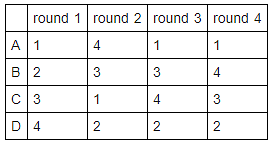
If A had the minimum possible score in round 1, who won the tournament?
4 students participated in Indian High School mathematics tournament. The tournament had four rounds of tests. In each round, a test containing ten questions was given to each of the students. Each question carried 1 mark and there was no negative marking. The table above shows the rankings of the four students in each of the four rounds. Furthermore, the following facts are known about the tournament.
- Overall ranking of B was more than overall ranking of A.
- Each of the students solved at least 1 question correctly in each of the rounds.
- No two students got the same overall ranking
- A scored a perfect 10 in round 4
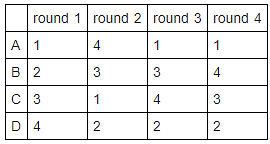
How much did D score in round 2?
4 students participated in Indian High School mathematics tournament. The tournament had four rounds of tests. In each round, a test containing ten questions was given to each of the students. Each question carried 1 mark and there was no negative marking. The table above shows the rankings of the four students in each of the four rounds. Furthermore, the following facts are known about the tournament.
- Overall ranking of B was more than overall ranking of A.
- Each of the students solved at least 1 question correctly in each of the rounds.
- No two students got the same overall ranking
- A scored a perfect 10 in round 4
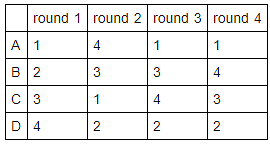
What is the maximum possible difference between points of overall rank 1 and overall rank 4 holder?
Directions: A leading Consulting firm organized a Selection Process at an Engineering College, where they made all students undergo three rounds, and on the basis of the cumulative performance across the rounds, the best few people were selected. Only 8 students had managed to clear the stringent eligibility criteria laid down by the company, to appear for the selection process. Below we have the scores and ranks obtained by the 8 students who appeared for the Placement process. Every round had a maximum score of 10, and every score was in either integer or 0.5 format. People having tied average scores were ranked based on a secret procedure, not known. Certain information is missing from the table.
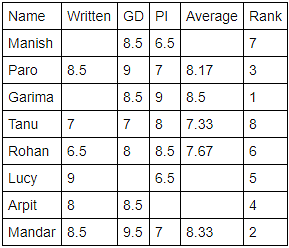
How many candidates definitely scored more than Manish in the Written Test?
Directions: A leading Consulting firm organized a Selection Process at an Engineering College, where they made all students undergo three rounds, and on the basis of the cumulative performance across the rounds, the best few people were selected. Only 8 students had managed to clear the stringent eligibility criteria laid down by the company, to appear for the selection process. Below we have the scores and ranks obtained by the 8 students who appeared for the Placement process. Every round had a maximum score of 10, and every score was in either integer or 0.5 format. People having tied average scores were ranked based on a secret procedure, not known. Certain information is missing from the table.
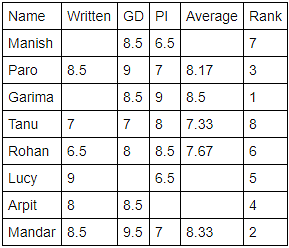
How many possible values can Arpit get in his PI?
Directions: Ram rents a cab for his daily Kishenganj-Joomla-Kishenganj round-trip. Distance between Kishenganj to Joomla is 200km
The cab-driver charges him Rs. 400 every day. On the 23rd of November, the cab driver informs Ram that there are two students Shyam and Mohit who wish to travel from Ranaghat to Joomla and then only Mohit back to Ranaghat, just for that day. Ranaghat is exact midway between Kishenganj and Joomla.
On the 30th of November, the cab driver informs Ram that there is one student Rishi who wishes to travel from Dhulna to Joomla and then he wants to return till Ranaghat, just for that day. Dhulna is exact midway between Ranaghat and Kishenganj.
Ram, on the both days the students came, told the cab-driver: "Keeping the original fare in mind and the basis for our calculations, I will only pay the amount which is arrived at after dividing the fare amongst all the co-riders proportionally (according to the respective distances we travel)."
Q. On the 23rd of November, Ram must pay the driver:
Directions: At Lacy's Technology Solutions, a special area of the parking space is reserved for the top C-level executives: CEO, CFO, CTO, COO and CMO. The parking spaces are also lined up in that order. The names of the C-Level Executives(in no particular order) are Vinodh, Frank, Rajat, Pankaj and Prince. The cars they travel in are of the following make(in no particular order) - Amaze, Ciaz, Audi, Honda City and BMW. The following information is also known about the cars:
-
The car in the first space is a Honda City
-
The Ciaz is parked between the Amaze and the Audi
-
The car in the last space is BMW
-
Prince's car is parked next to Frank's.
-
Rajat travels in a Ciaz
-
Vinodh's car is parked between Pankaj's and Prince's
-
Pankaj's car is parked in the last space
What is the designation of the person who travels in a Honda City?
Directions: At Lacy's Technology Solutions, a special area of the parking space is reserved for the top C-level executives: CEO, CFO, CTO, COO and CMO. The parking spaces are also lined up in that order. The names of the C-Level Executives(in no particular order) are Vinodh, Frank, Rajat, Pankaj and Prince. The cars they travel in are of the following make(in no particular order) - Amaze, Ciaz, Audi, Honda City and BMW. The following information is also known about the cars:
The car in the first space is a Honda City
The Ciaz is parked between the Amaze and the Audi
The car in the last space is BMW
Prince's car is parked next to Frank's.
Rajat travels in a Ciaz
Vinodh's car is parked between Pankaj's and Prince's
Pankaj's car is parked in the last space
What car does Frank travel in?
Directions: Read the following information and answer the question the follows:
In recently held Common Admission Test (CAT) exam, five female friends P, Q, R, S and T were comparing their marks in of three sections namely Quantitative aptitude (QA), Data Interpretation and Logical Reasoning (DILR), and Verbal Ability and Reading Comprehension (VARC). The diagrams given below show marks scored by them in each of the sections. The outer circles represent the marks scored by three girls who scored the highest marks in that section. Also the middle circle represents the percentage of marks scored by these three girls as a percentage of total marks scored by all the five girls in that particular section.
Given that no two girls scored the same marks in any of the sections and also marks scored by all the girls are integer and each girl scored at least 20 marks in each section.
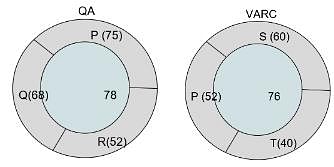
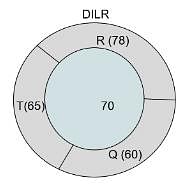
To check the consistency in their scores, they devised a consistency Index (CI) which is the difference between the highest and lowest score in the three sections and a reliability index (RI), which is the middle value when the scores of each girl are arranged in increasing order.
Q. Which of the following can not be the score of Q in all the three sections combined?
A string is length 10 meters is divided in two parts by a random cut. What is the probability that the longer part is at least twice the smaller part?
An isosceles Δ ADB with base angles ∠DAB = ∠ABD = 80°. Another isosceles ΔCDB is constructed taking with base angles ∠CDB =∠CBD = 40°.
Find AC2 BD2 if it is given that area of cyclic quadrilateral ABCD so formed has area 12 square units.
Three faces of a biased die are colored with yellow, blue and red. The dice is rolled 21 times and the number of outcomes of n (1 to 6) is n (1 to 6 of the 21 outcomes). But the probability of the outcome of each color is equal for all the colours. Which faces were coloured blue, given that the variance of the number set coloured with blue is highest among the three respective variances of yellow, blue and red?
If N is a 26 digit number, and M= log 10.
Let F(x) = logN/M, what will be the integral part of F(x)?
If S = 58 + 158 + 258 + 358 + 458 + 558 + 658 + 758 then what is the remainder if S is divided by 24?
For the same principal amount, the compound interest for two years at 5% per annum exceeds the simple interest for three years at 3% per annum by Rs 1125. Then the principal amount in rupees is
Given that f(x) = 1/|x| and g(x) = x2/|x| are two curves. At how many points do these curves intersect each others?
If (32)n(13)n-1 = (198)n+4. (Read (32)n as 32 in base n). What is the value of n + 3?
The cost of 3 pens, 2 pencils and 6 erasers is Rs.23 while the cost of 2 pens, 5 pencils and an eraser is Rs.12. Then the cost of 4 pens and 21 pencils is greater than the cost of 7 erasers by
Find the sum of areas enclosed between arc AB and line AB, between arc BC and line BC and between arc CD and line CD where ABCD is isosceles trapezium inscribed in a circle of radius 20 cm so that the non-parallel sides are 20 cm each and AD is the diameter of the circle?
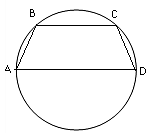
Consider two positive integers a and b such that aabb is divisible by 2000. What is the least possible value of the product ab?
|
152 docs|327 tests
|



